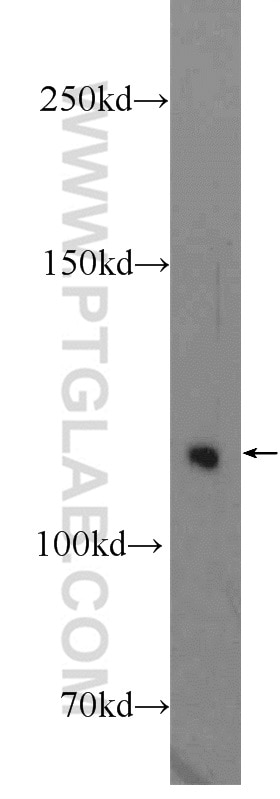Validation Data Gallery
Tested Applications
| Positive WB detected in | mouse brain tissue |
Recommended dilution
| Application | Dilution |
|---|---|
| Western Blot (WB) | WB : 1:200-1:400 |
| It is recommended that this reagent should be titrated in each testing system to obtain optimal results. | |
| Sample-dependent, Check data in validation data gallery. | |
Published Applications
| WB | See 1 publications below |
Product Information
14620-1-AP targets TUBGCP5 in WB, ELISA applications and shows reactivity with human, mouse, rat samples.
| Tested Reactivity | human, mouse, rat |
| Cited Reactivity | mouse |
| Host / Isotype | Rabbit / IgG |
| Class | Polyclonal |
| Type | Antibody |
| Immunogen |
CatNo: Ag6248 Product name: Recombinant human TUBGCP5 protein Source: e coli.-derived, PGEX-4T Tag: GST Domain: 676-1024 aa of BC071560 Sequence: ESVTCQTFELTLRSCLYPHIDKQYLDCCGNLMQTLKKDYRLVEYLQAMRNFFLMEGGDTMYDFYTSIFDKIREKETWQNVSFLNVQLQEAVGQRYPEDSSRLSISFENVDTAKKKLPVHILDGLTLSYKVPWPVDIVISLECQKIYNQVFLLLLQIKWAKYSLDVLLFGELVSTAEKPRLKEGLIHEQDTVAQFGPQKEPVRQQIHRMFLLRVKLMHFVNSLHNYIMTRILHSTGLEFQHQVEEAKDLDQLIKIHYRYLSTIHDRCLLREKVSFVKEAIMKVLNLALMFADGWQAGLGTWRMESIEKMESDFKNCHMFLVTILNKAVCRGSFPHLESLALSLMAGMEQS 相同性解析による交差性が予測される生物種 |
| Full Name | tubulin, gamma complex associated protein 5 |
| Calculated molecular weight | 118 kDa |
| Observed molecular weight | 118-120 kDa |
| GenBank accession number | BC071560 |
| Gene Symbol | TUBGCP5 |
| Gene ID (NCBI) | 114791 |
| RRID | AB_2878070 |
| Conjugate | Unconjugated |
| Form | |
| Form | Liquid |
| Purification Method | Antigen affinity purification |
| UNIPROT ID | Q96RT8 |
| Storage Buffer | PBS with 0.02% sodium azide and 50% glycerol{{ptg:BufferTemp}}7.3 |
| Storage Conditions | Store at -20°C. Stable for one year after shipment. Aliquoting is unnecessary for -20oC storage. |
Protocols
| Product Specific Protocols | |
|---|---|
| WB protocol for TUBGCP5 antibody 14620-1-AP | Download protocol |
| Standard Protocols | |
|---|---|
| Click here to view our Standard Protocols |

